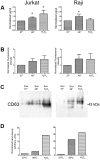Thermal- and oxidative stress causes enhanced release of NKG2D ligand-bearing immunosuppressive exosomes in leukemia/lymphoma T and B cells
- PMID: 21364924
- PMCID: PMC3045385
- DOI: 10.1371/journal.pone.0016899
Thermal- and oxidative stress causes enhanced release of NKG2D ligand-bearing immunosuppressive exosomes in leukemia/lymphoma T and B cells
Abstract
Immune evasion from NK surveillance related to inadequate NK-cell function has been suggested as an explanation of the high incidence of relapse and fatal outcome of many blood malignancies. In this report we have used Jurkat and Raji cell lines as a model for studies of the NKG2D receptor-ligand system in T-and B cell leukemia/lymphoma. Using real-time quantitative RT-PCR and immunoflow cytometry we show that Jurkat and Raji cells constitutively express mRNA and protein for the stress-inducible NKG2D ligands MICA/B and ULBP1 and 2, and up-regulate the expression in a cell-line specific and stress-specific manner. Furthermore, we revealed by electron microscopy, immunoflow cytometry and western blot that these ligands were expressed and secreted on exosomes, nanometer-sized microvesicles of endosomal origin. Acting as a decoy, the NKG2D ligand-bearing exosomes downregulate the in vitro NKG2D receptor-mediated cytotoxicity and thus impair NK-cell function. Interestingly, thermal and oxidative stress enhanced the exosome secretion generating more soluble NKG2D ligands that aggravated the impairment of the cytotoxic response. Taken together, our results might partly explain the clinically observed NK-cell dysfunction in patients suffering from leukemia/lymphoma. The adverse effect of thermal and oxidative stress, enhancing the release of immunosuppressive exosomes, should be considered when cytostatic and hyperthermal anti-cancer therapies are designed.
Conflict of interest statement
Figures





References
-
- Coudert JD, Held W. The role of NKG2D receptor in tumor immunity. Sem Cancer Biol. 2006;16:333–343. - PubMed
-
- Pende D, Cantoni C, Rivera P, Vitale M, Castriconi R, et al. Role of NKG2D in tumor cell lysis mediated by human NK cells: cooperation with natural cytotoxicity receptors and capability of recognizing tumors of neoepithelial origin. Eur J Immunol. 2001;31:1076–1086. - PubMed
Publication types
MeSH terms
Substances
LinkOut - more resources
Full Text Sources
Other Literature Sources

